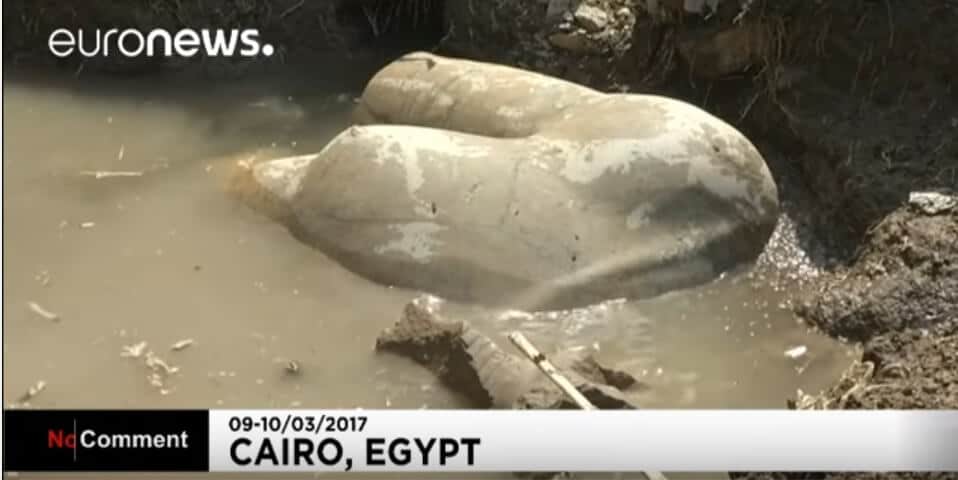Archaeologists first discovered the head and bust of a statue of one of the most powerful pharaohs of the 19th dynasty, Ramesses II (1279-1213 BC). The rare statue is found in a layer of groundwater in the Matariya neighborhood, a working-class neighborhood east of Cairo. In Egypt and the archaeological community are concerned about the poor level of preservation of antiquities throughout the country

A statue of Ramses II with an estimated height of about 8 meters was discovered east of Cairo by German archaeologists excavating near Cairo. Archaeologists first discovered the head and bust of a statue of one of the most powerful pharaohs, the third pharaoh of the 19th dynasty, Ramses II (1279-1213 BC), that is, more than 3,000 years ago. The rare statue is found in a layer of groundwater in the Matariya neighborhood, a working-class neighborhood east of Cairo. Next to the statue of Ramses II, a smaller statue was also discovered, this time only in 1:1 size of his grandson - Sethi II as a baby, 80 centimeters. The joint German-Egyptian delegation was led by the University of Leipzig.
The discovery announced by the Egyptian Ministry of Antiquities on March 9 is one of the most important at the site, which is located near the remains of the temple of Ramses II in the ancient city of Heliopolis, which today lies in the eastern part of Cairo. The statue was discovered when it was dismantled and submerged in a layer of groundwater. The announcement of the Egyptian Ministry of Antiquities said that it was a great discovery of a huge statue of a king, most likely Ramses II or Ramses the Great who was the most powerful and revered Pharaoh. While many statues of Ramses II have been discovered in the past, none came close to this size.
During his time, Egypt's rule included territories from Syria in the east to the Nubian desert in the south, including of course the land of Canaan.
Ramses II reigned over Egypt for about 68 years - a long period even considering the meager life expectancy that was then even for members of the royal family (who also used to marry within the family). It is believed that he lived to the age of 90. His reign marked the last peak of Egyptian imperial power.
The great king led a period of military expansion in Egypt. He devoted protracted efforts to building palaces and temples, including the well-known Abu Simbel temple in southern Egypt that were prominent in Egyptian history.
His mother's mummified body was discovered in 1881 and it was transferred to the Egyptian Museum in Cairo, where it quickly became one of the country's biggest tourist attractions.
As mentioned, the findings were found near Heliopolis - or the city of the sun in Greek, in the northeastern part of modern Cairo, the temple of the sun in Heliopolis was founded by Ramses II, which increases the likelihood that it is his statue. The temple was twice as big as the Karnak temple in Luxor but it was destroyed in wars during the Greek and Roman periods.
Most of the obelisks from this temple were moved to Alexandria and stones from the site were looted and used for construction when Cairo developed.
The local media recorded the diggers using a hydraulic excavator to extract the head from the wet dirt and showed workers splashing buckets of water on it. The photos caused an uproar, with the ministry criticized for not using more advanced methods to excavate the new discovery.
Mahmoud Afifi, head of the Egyptian Antiquities Authority at the Ministry of Antiquities, said in a statement published on Thursday that the head was removed using the excavator, but wood and cork were also used to ensure that the statue would not be damaged. He added that the rescue was conducted under the supervision of German and Egyptian archaeologists.
The official went on to state that the other parts of the statue remained in the ground and the archaeologists will develop additional methods to extract them. When the statue is fully extracted it will be transferred to the Great Egyptian Museum which is scheduled to be inaugurated in 2018.
Egypt's heritage sites are already infested with trespassers and plundered by the local community. Mataria neighborhood is known for illegal digging and treasure hunting. Dozens of incidents have been reported of bodies of people trying to dig in their backyard and falling victim to accidents. In 2013, the United Nations Economic Scientific Cultural Organization (UNESCO) threatened to declassify six archaeological sites in Egypt citing a lack of experts in Egypt to manage the sites as a reason. The sites included the Great Pyramid of Giza, the Karnak Temple in Luxor, the Temples of Abu Simbel, the Monastery of Santa Catherine, the Monastery of Saint Mina, and the Islamic in Cairo.
https://www.youtube.com/watch?v=OxiduBc54Ms

4 תגובות
With all due respect, don't you think it's time for new articles? For over a week now I've been stuck with Ramses every morning when first thing I eagerly open the science and look forward to fresh archeological news and Nada
With all due respect, don't you think it's time for new articles? For over a week now I've been stuck with Ramses every morning when first thing I eagerly open the science and look forward to fresh archeological news and Nada
Let's hope that extreme Islam will not come to power again in the Straits and all the antiquities there will be destroyed.
Hello Lidan, thanks for the interesting articles. The translation needs proofreading,
The grammar and sentence structure of the source languages is not clear in Hebrew. - "Egypt's heritage sites are already infested with trespassers and looters from the local community... ... In 2013, the United Nations Economic, Cultural, Scientific and Cultural Organization (UNESCO) threatened to declassify six archaeological sites in Egypt citing a lack of experts in Egypt to manage the sites as a reason."